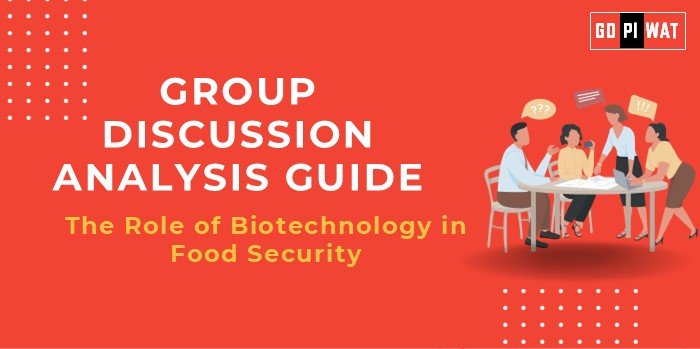📋 Group Discussion (GD) Analysis Guide: The Role of Biotechnology in Addressing Food Security Challenges
🌐 Introduction to Biotechnology and Food Security
- Opening Context: With the global population projected to reach 9.7 billion by 2050, ensuring food security is a critical challenge. Biotechnology offers innovative solutions by enhancing crop productivity, improving nutritional content, and enabling sustainable agriculture.
- Topic Background: Since the advent of genetically modified (GM) crops in the 1990s, biotechnology has significantly impacted global agriculture. Recent advancements in CRISPR gene-editing and bio-fortified crops highlight its growing relevance.
📊 Quick Facts and Key Statistics
• 🌍 Global Food Insecurity: 720-811 million people faced hunger in 2022 (FAO).
• 🌱 Biotech Crops Adoption: 190 million hectares of GM crops grown worldwide in 2023.
• 📈 Yield Improvement: GM crops have increased yields by 22% (National Academy of Sciences, 2022).
• 💰 Economic Benefits: Biotechnology added $19 billion to farmer incomes globally in 2021.
• 🌱 Biotech Crops Adoption: 190 million hectares of GM crops grown worldwide in 2023.
• 📈 Yield Improvement: GM crops have increased yields by 22% (National Academy of Sciences, 2022).
• 💰 Economic Benefits: Biotechnology added $19 billion to farmer incomes globally in 2021.
🤝 Stakeholders and Their Roles
- 🏛️ Government Agencies: Create regulatory frameworks for GMOs and support research initiatives.
- 💡 Private Sector: Invests in biotech R&D and commercializes bioengineered seeds.
- 👩🌾 Farmers: Utilize biotech crops for better yields and reduced resource use.
- 🌐 Global Organizations: Agencies like FAO promote sustainable biotechnologies to combat hunger.
- 👥 Consumers: Demand safer, healthier, and sustainable food options.
🏆 Achievements and ⚠️ Challenges
✨ Achievements
- Higher Yields: GM crops like Bt cotton and Golden Rice increase production.
- Climate-Resilience: Drought-tolerant maize benefits arid regions.
- Reduced Chemical Use: Herbicide-resistant crops reduce pesticide dependency.
- Global Case Study: Adoption of Bt cotton in India increased productivity by 50%.
⚠️ Challenges
- Public Opposition: Concerns about GMOs’ safety and ethical issues.
- Regulatory Hurdles: Prolonged approval processes hinder adoption.
- Global Comparison: While the US and Brazil lead in GM adoption, the EU has stringent restrictions.
- Case Study: Kenya’s cautious approach to GMOs despite severe food crises.
💡 Structured Arguments for Discussion
- ⚖️ Supporting Stance: “Biotechnology is the key to feeding a growing global population sustainably.”
- 🔄 Opposing Stance: “Biotech advancements risk ecological balance and consumer health.”
- 🌟 Balanced Perspective: “While biotechnology offers solutions to food security, its implementation needs stringent oversight.”
🗣️ Effective Discussion Approaches
- Opening Approaches:
- “With one in nine people globally facing hunger, how can biotechnology be a game-changer in food security?”
- “What role can gene-editing technologies like CRISPR play in combating malnutrition?”
- Counter-Argument Handling:
- Highlight successful examples of biotech crops.
- Emphasize the importance of regulations to address concerns.
📈 Strategic Analysis (SWOT)
- Strengths: High yield potential, reduced resource usage.
- Weaknesses: Ethical concerns, lack of public awareness.
- Opportunities: Gene-editing, bio-fortified crops.
- Threats: Regulatory delays, misinformation.
📘 Connecting with B-School Applications
- Real-World Applications: Link to project themes like agritech startups or supply chain optimization.
- Sample Interview Questions:
- “How can biotechnology support sustainable development goals?”
- “Discuss the economic impact of GM crops.”
- Insights for B-School Students:
- Explore biotech’s role in entrepreneurship.
- Analyze policy impacts on agribusiness.


